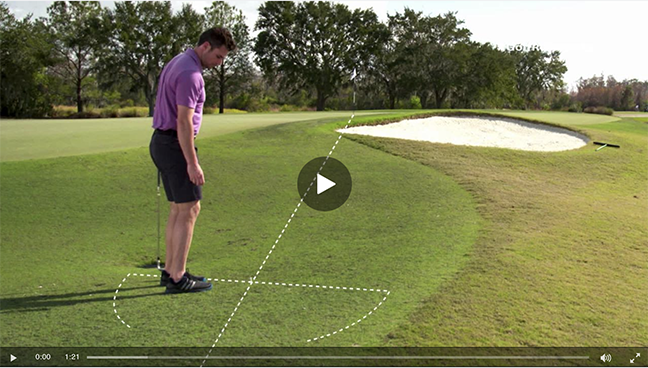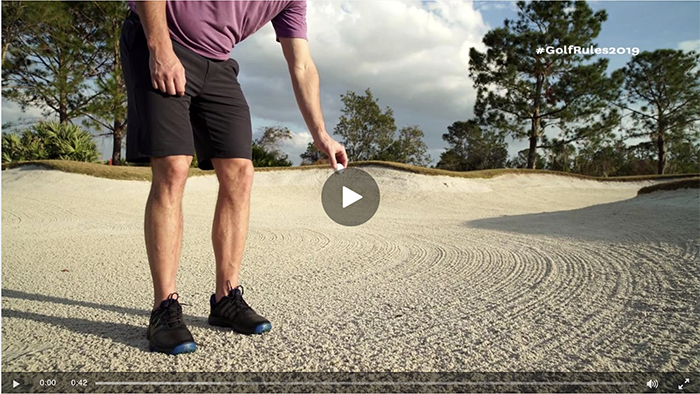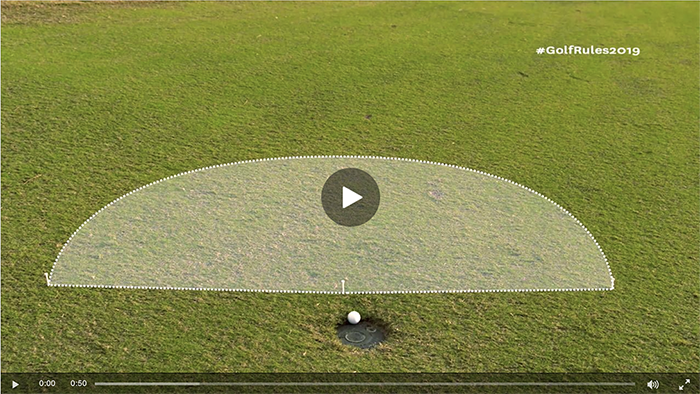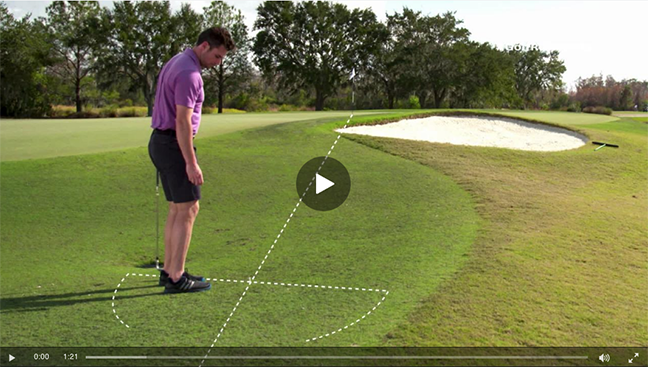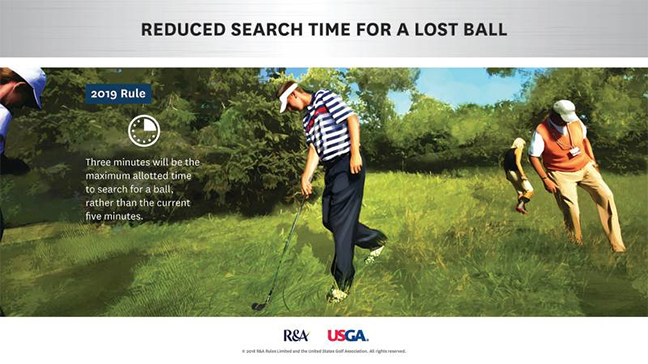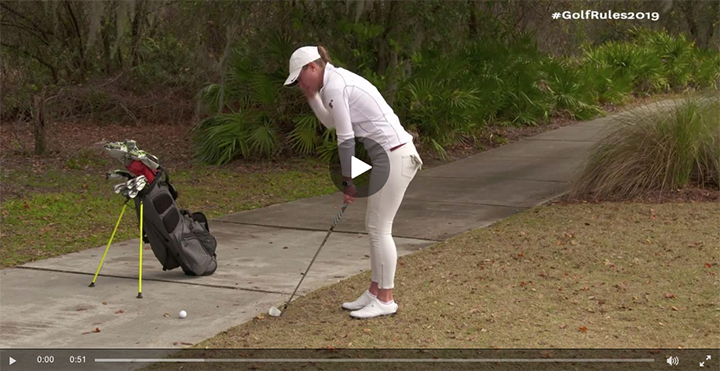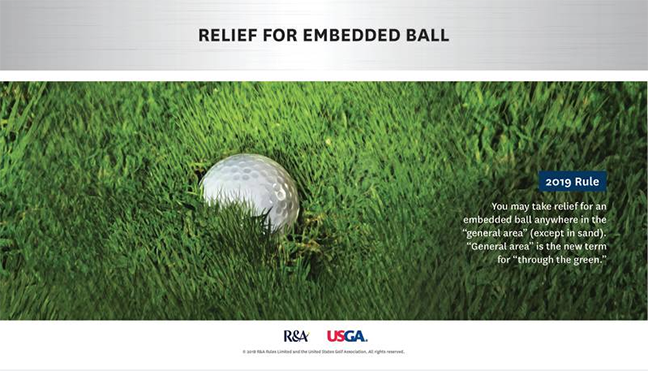Taking Relief
2019 Golf Rule Changes
Become comfortable with the rule changes to help you this season.
Topic 3 | Taking Relief
Rule – Measuring the size of the relief area where a ball must be dropped and played
Your relief area for dropping a ball will be a fixed size of either one or two club-lengths using the longest club in your bag, other than your putter.
2019 Rule: Players will continue to drop a ball when taking relief, but the dropping procedure will be changed in several ways as detailed in Rule 14.3:
- The focus of the dropping procedure will be on a specific “relief area” set by the Rule under which relief is being taken and will be either one or two club-lengths from a reference point (and may have certain other limitations).
- The relief area is a fixed size for each player and is pre-determined based on the clubs the player has selected for play.
Reasons for Change:
The new procedure lowers the height from which the ball is dropped to increase the chance that it stays within the relief area.
Requiring the player to drop a ball (as opposed to placing it) will retain a desired randomness about where the ball will end up:
- For example, many times today a player is required to drop a ball as near as possible to a certain spot (such as where the previous stroke was made or where a ball was embedded) and questions can arise about whether it was dropped near enough to that spot.
- The new procedure when dropping with reference to a spot will be to drop a ball anywhere in a relief area measured one or two club-lengths from (but not nearer the hole than) that spot.
The definition of a club-length as the longest club other than a putter will mean that a player cannot choose which club to measure with based on the situation.
For example, players will no longer be able to make a strategic choice about the size of the relief area by choosing a longer club so that the player can reach a location that is farther from the nearest point of relief or other reference point.
Using the longest club for measuring will minimize the inconsistency in the size of a relief area between players (including eliminating the advantage for players who currently can use a long putter for measuring).
Check out the VIDEO:
Rule – New procedure for dropping a ball
New standard to determine if you caused your ball to move.
2019 Rule: Under Rule 9.2, the “known or virtually certain” standard (meaning at least 95% likely) will apply to all questions of fact about why a ball at rest moved:
- How a ball may be dropped is simplified; the only requirement will be that the ball be let go from knee height so that it falls through the air and does not touch any part of the player’s body or equipment before it hits the ground.
Reasons for Change:
The new procedure lowers the height from which the ball is dropped to increase the chance that it stays within the relief area. Requiring the player to drop a ball (as opposed to placing it) will retain a desired randomness about where the ball will end up:
- The player has no guarantee that the ball will come to rest on a desired spot or in a good lie.
- There is no prescribed way of prioritizing or balancing these factors.
Allowing the player to drop a ball from knee height will help to limit the extent to which a ball will embed in sand in a bunker.
Check out the VIDEO:
Rule – When a dropped ball must come to rest
Your ball must come to rest in the relief area where it was dropped, or else it must be re-dropped.
2019 Rule: Players will continue to drop a ball when taking relief, but the dropping procedure will be changed in several ways as detailed in Rule 14.3:
- The ball will need only to be dropped in and come to rest in the relief area; and there will be no re-drop requirement if the dropped ball accidentally hits a person or object after hitting the ground but before coming to rest in the relief area.
- If the dropped ball comes to rest outside the relief area, it will be dropped a second time; if it comes to rest outside the relief area after being dropped a second time, it will be placed where it first touched the ground.
- If the placed ball will not come to rest on that spot after two attempts, the player will then place the ball on the nearest spot (not nearer the hole) where it will come to rest.
Reasons for Change:
The new procedure avoids giving players more relief than necessary:
- A dropped ball is currently allowed to roll up to two club-lengths from where it hits the ground – so that, for example, it can end up being played up to three club-lengths from the nearest point of relief from a cart path or ground under repair, or up to four club-lengths from where the original ball went into a lateral water hazard or where it was unplayable.
- Requiring the dropped ball to come to rest in and be played from the same relief area where it was dropped will make it much more likely that the ball will be played from close to where it originally came to rest.
The new procedure will mean there will be greater consistency across all relief procedures, making it simpler for players to know where and how to drop a ball:
- For example, many times today a player is required to drop a ball as near as possible to a certain spot (such as where the previous stroke was made or where a ball was embedded) and questions can arise about whether it was dropped near enough to that spot.
- The new procedure when dropping with reference to a spot will be to drop a ball anywhere in a relief area measured one or two club-lengths from (but not nearer the hole than) that spot.
It will be simpler for players to know when to re-drop a ball:
- A player currently needs to know the nine re-dropping scenarios in Rule 20-2c; these are difficult to understand and apply and this is a widely misunderstood Rule.
- Under the new Rule, the player will only need to know that the ball must be re-dropped if it comes to rest outside the relief area.
Check out the VIDEO:
Rule – Fixed distances to be used for measuring
A fixed distance of the longest club in your bag, other than your putter, will be used for measuring
2019 Rule: A club-length will be defined as the length of the longest club in the player’s bag, except that this cannot be his or her putter.
- The relief area for dropping a ball will be a fixed size of either one or two club-lengths depending on which relief Rule is being used.
- The relief area is a fixed size for each player and is pre-determined based on the clubs the player has selected for play.
Reasons for Change:
The definition of a club-length as the longest club other than a putter will mean that a player cannot choose which club to measure with based on the situation.
For example, players will no longer be able to make a strategic choice about the size of the relief area by choosing a longer club so that the player can reach a location that is farther from the nearest point of relief or other reference point.
Using the longest club for measuring will minimize the inconsistency in the size of a relief area between players (including eliminating the advantage for players who currently can use a long putter for measuring).
Check out the VIDEO:
Rule – Time for search before ball is lost
Your ball is lost if not found in 3 minutes (rather than the current 5 minutes)
2019 Rule: Under Rule 18.2, the time for a ball search (before the ball becomes lost) will be reduced from 5 minutes to 3 minutes.
Reasons for Change:
Limiting the search period to 3 minutes is more consistent with the underlying principle that golf is to be played in a prompt and continuous way, without long pauses in play.
In most cases, if the ball is going to be found, it will be found within the first 3 minutes.
Although this change may increase the number of lost balls, on average the overall impact should be to speed up play.
Knowing that the search time is limited to 3 minutes should encourage players to play a provisional ball when they believe there is a chance their ball may not be found.
Rule – Substitution of ball always allowed when taking relief
You may always substitute a ball when taking relief
2019 Rule: Under Rule 14.3, when taking relief, the player will always be allowed the choice to substitute a ball or to use the original ball, including:
- When taking penalty relief as well as when taking free relief (Rules 15-19).
Reasons for Change:
The requirement to use the original ball in some relief situations but not others is confusing, hard to remember and leads to unnecessary penalties. Taking a consistent approach that always allows a player taking relief the choice to substitute a ball or use the original ball is much simpler.
There is no need for a different procedure based on whether the player is taking relief with penalty or without penalty.
This will also draw a clearer and more intuitive line between when substitution is allowed in returning a ball to play and when the original ball must be returned to play:
- Substitution will be allowed only when a player is taking relief under any Rule – that is, when the player is required or allowed to play the next stroke from somewhere other than where the original ball came to rest.
- Substitution will not be allowed when a ball was lifted or moved, and the Rules require it to be replaced on its original spot – in that case, the original ball must still be used (unless it cannot be recovered with reasonable effort and in a few seconds).
Check out the VIDEO:
Rule – Relief for an embedded ball
Relief allowed without penalty for an embedded ball anywhere (except in the sand) in the “general area” (a new term for “through the green”).
2019 Rule: The current default position in the Rules will be reversed:
- Rule 16.3 will allow relief for a ball embedded anywhere in the “general area” (that is, the area currently known as “through the green”), except when embedded in sand.
- But a Committee may adopt a Local Rule restricting relief to a ball embedded in those parts of the general area cut to fairway height or less.
- In taking relief, the player will drop the original ball or a substituted ball within one club-length of (but not nearer the hole than) the spot right behind where the ball was embedded.
Reasons for Change:
This is an appropriate exception to the principle of playing the ball as it lies because having to play a ball that is stuck in soft or wet ground (whether in the fairway or the rough) should not be considered part of the normal challenge of playing a course.
Allowing relief throughout the general area is consistent with other relief Rules, which do not make distinctions based on the height of the grass in the general area.
In many countries, the Local Rule is sufficiently well established that golfers assume that the Rules always allow relief anywhere in the general area.
Reversing the default position will help avoid the confusion that sometimes exists today when clubs or players do not realize that such relief is not allowed unless a Local Rule has been adopted.
Check out the VIDEO:
